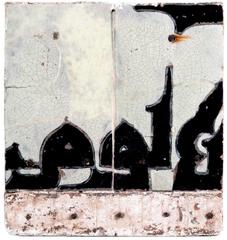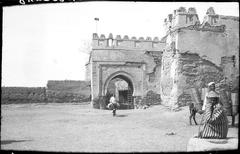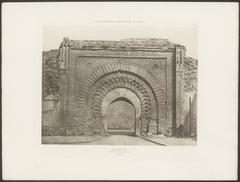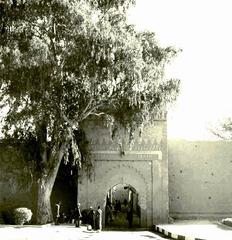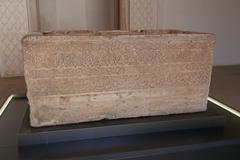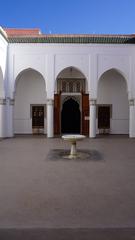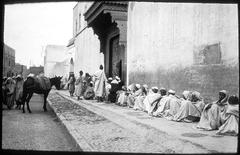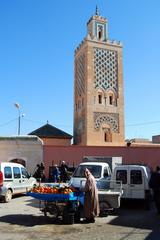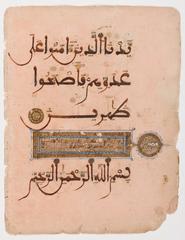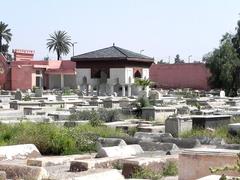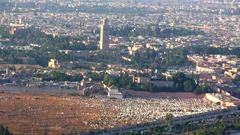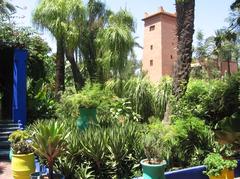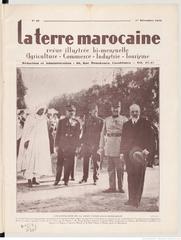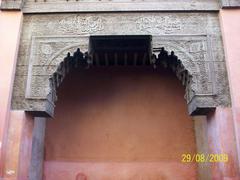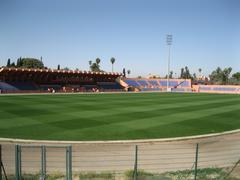Comprehensive Guide to Visiting Palais Bahia, Marrakesh, Morocco
Date: 17/07/2024
Introduction
Nestled in the heart of Marrakesh, Morocco, Palais Bahia (قصر الباهية) stands as a testament to the nation’s rich cultural and architectural heritage. Commissioned in the late 19th century by Si Moussa, the Grand Vizier of Sultan Hassan I, and later expanded by his son Ahmed ben Moussa (Ba Ahmed), the palace was designed to be a symbol of opulence and grandeur. Covering an expansive 8 hectares, the palace features a labyrinth of rooms, serene courtyards, and lush gardens, showcasing the finest examples of Moroccan and Islamic architectural influences. The name ‘Bahia,’ meaning ‘brilliance’ or ‘beautiful’ in Arabic, encapsulates the palace’s intended splendor and its role as a cultural icon.
Palais Bahia has witnessed significant historical events and has been a residence for Moroccan royalty and French colonial officials. Over the years, it has also served as a venue for political meetings, royal ceremonies, and diplomatic gatherings, further cementing its status as a symbol of power and authority. Today, the palace is managed by the Moroccan Ministry of Culture and welcomes visitors from around the world, offering them a glimpse into Morocco’s storied past and architectural mastery.
This comprehensive guide aims to provide you with all the essential information you need to make the most of your visit to Palais Bahia. From its rich history and architectural significance to practical visitor tips and travel advice, this guide will help you navigate and appreciate one of Marrakesh’s most iconic landmarks.
Table of Contents
- Introduction
- History of Palais Bahia قصر الباهية, Marrakesh, Morocco
- Visitor Information
- Travel Tips
- Frequently Asked Questions (FAQ)
- Conclusion
- Sources
History of Palais Bahia قصر الباهية, Marrakesh, Morocco
Origins and Construction
The Palais Bahia, or Bahia Palace, is a stunning example of Moroccan architecture and a significant historical landmark in Marrakesh. The palace’s construction began in the late 19th century, around 1866, under the orders of Si Moussa, the Grand Vizier of Sultan Hassan I of Morocco. The initial phase of the palace was relatively modest, intended as a private residence for Si Moussa and his family. However, the palace’s grandeur expanded significantly under the direction of Si Moussa’s son, Ahmed ben Moussa, also known as Ba Ahmed, who succeeded his father as Grand Vizier.
Ba Ahmed’s vision for the palace was ambitious. He aimed to create the most magnificent palace of its time, reflecting the wealth and power of the Moroccan elite. The construction and expansion continued for over a decade, involving the finest artisans and craftsmen from across Morocco. The palace was completed in the early 20th century, around 1900, and it covered an area of approximately 8 hectares (20 acres).
Architectural Significance
The architectural style of Palais Bahia is a blend of Islamic and Moroccan influences, characterized by intricate stucco work, zellige tile mosaics, and carved wooden ceilings. The palace’s layout is a labyrinth of rooms, courtyards, and gardens, designed to provide privacy and comfort to its inhabitants. The name “Bahia” means “brilliance” or “beautiful” in Arabic, reflecting the palace’s intended splendor.
One of the most notable features of the palace is the Grand Courtyard, which is surrounded by rooms that were used by Ba Ahmed’s four wives and 24 concubines. The courtyard is adorned with a central fountain, marble floors, and lush gardens, creating a serene and opulent environment. The palace also includes a harem section, which was strictly off-limits to men other than the sultan and his closest advisors.
Historical Events and Usage
Throughout its history, Palais Bahia has played a significant role in Moroccan politics and society. After Ba Ahmed’s death in 1900, the palace was seized by Sultan Abdelaziz, who used it as a royal residence. During the French Protectorate in Morocco (1912-1956), the palace served as the residence of the French Resident-General, further cementing its status as a symbol of power and authority.
The palace has witnessed numerous historical events, including political meetings, royal ceremonies, and diplomatic gatherings. Its strategic location in the heart of Marrakesh made it an ideal venue for hosting important guests and dignitaries. The palace’s opulent design and luxurious amenities were intended to impress and intimidate visitors, showcasing the wealth and sophistication of the Moroccan elite.
Preservation and Restoration
In the years following Morocco’s independence in 1956, Palais Bahia underwent several restoration projects to preserve its historical and architectural integrity. The Moroccan government recognized the palace’s cultural significance and invested in its maintenance and conservation. Today, the palace is managed by the Moroccan Ministry of Culture and is open to the public as a museum and tourist attraction.
The restoration efforts have focused on preserving the original materials and craftsmanship, ensuring that the palace remains a testament to Moroccan architectural heritage. The intricate stucco work, zellige tiles, and carved wooden ceilings have been meticulously restored, allowing visitors to appreciate the palace’s beauty and historical significance.
Cultural Impact
Palais Bahia is not only a historical monument but also a cultural icon in Marrakesh. It has inspired numerous artists, writers, and filmmakers, who have drawn inspiration from its stunning architecture and rich history. The palace has been featured in various films and documentaries, showcasing its beauty to a global audience.
The palace also plays a vital role in promoting Moroccan culture and heritage. It hosts cultural events, exhibitions, and performances, providing a platform for local artists and performers to showcase their talents. The palace’s gardens and courtyards serve as venues for traditional music and dance performances, offering visitors a glimpse into Morocco’s vibrant cultural traditions.
Visitor Information
Ticket Prices and Opening Hours
- Opening Hours: Palais Bahia is open daily from 9:00 AM to 5:00 PM. It is advisable to check the official website for any changes in the schedule.
- Ticket Prices: Admission fees are approximately 70 Moroccan Dirhams (MAD) for adults and 30 MAD for children. Discounts may be available for groups and students.
Guided Tours
Guided tours are available in multiple languages, providing historical context and insights into the palace’s significance. These tours cover the palace’s history, architecture, and cultural impact, offering a comprehensive understanding of this iconic landmark.
Travel Tips
Best Time to Visit
The best time to visit Palais Bahia is in the morning or late afternoon when the palace is less crowded, allowing for a more relaxed and enjoyable experience. Be prepared for the warm climate of Marrakesh and wear comfortable clothing and footwear.
Nearby Attractions
While visiting Palais Bahia, consider exploring other historical sites and attractions in Marrakesh, such as:
- Jemaa el-Fnaa: The bustling main square of Marrakesh, known for its vibrant atmosphere and street performers.
- Koutoubia Mosque: The largest mosque in Marrakesh, renowned for its stunning minaret.
- Saadian Tombs: Historic royal tombs dating back to the Saadian dynasty.
Frequently Asked Questions (FAQ)
- What are the opening hours of Palais Bahia?
- Palais Bahia is open daily from 9:00 AM to 5:00 PM.
- How much are the tickets for Palais Bahia?
- Admission fees are approximately 70 MAD for adults and 30 MAD for children.
- Are guided tours available?
- Yes, guided tours are available in multiple languages.
Conclusion
A visit to Palais Bahia is undoubtedly a highlight of any trip to Marrakesh. The palace’s rich history, stunning architecture, and cultural significance offer a deep dive into Morocco’s past and present. As you wander through its intricate rooms, courtyards, and gardens, you’ll gain a profound appreciation for the craftsmanship and vision that went into creating this stunning landmark. Whether you’re a history buff, an architecture enthusiast, or simply a curious traveler, Palais Bahia promises an enriching and memorable experience.
To make the most of your visit, consider exploring during the less crowded morning or late afternoon hours, and don’t miss the opportunity to take a guided tour to fully appreciate the palace’s historical and cultural context. Additionally, be sure to explore nearby attractions such as Jemaa el-Fnaa, Koutoubia Mosque, and the Saadian Tombs to round out your cultural journey in Marrakesh.
By following the tips and insights provided in this guide, you’ll be well-prepared to immerse yourself in the splendor of Palais Bahia and the vibrant cultural tapestry of Marrakesh. Don’t forget to check out other related posts, download the Audiala app for more travel tips, and stay connected with us on social media for the latest updates on Moroccan cultural sites.
